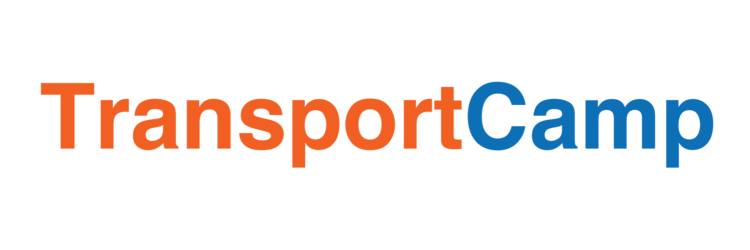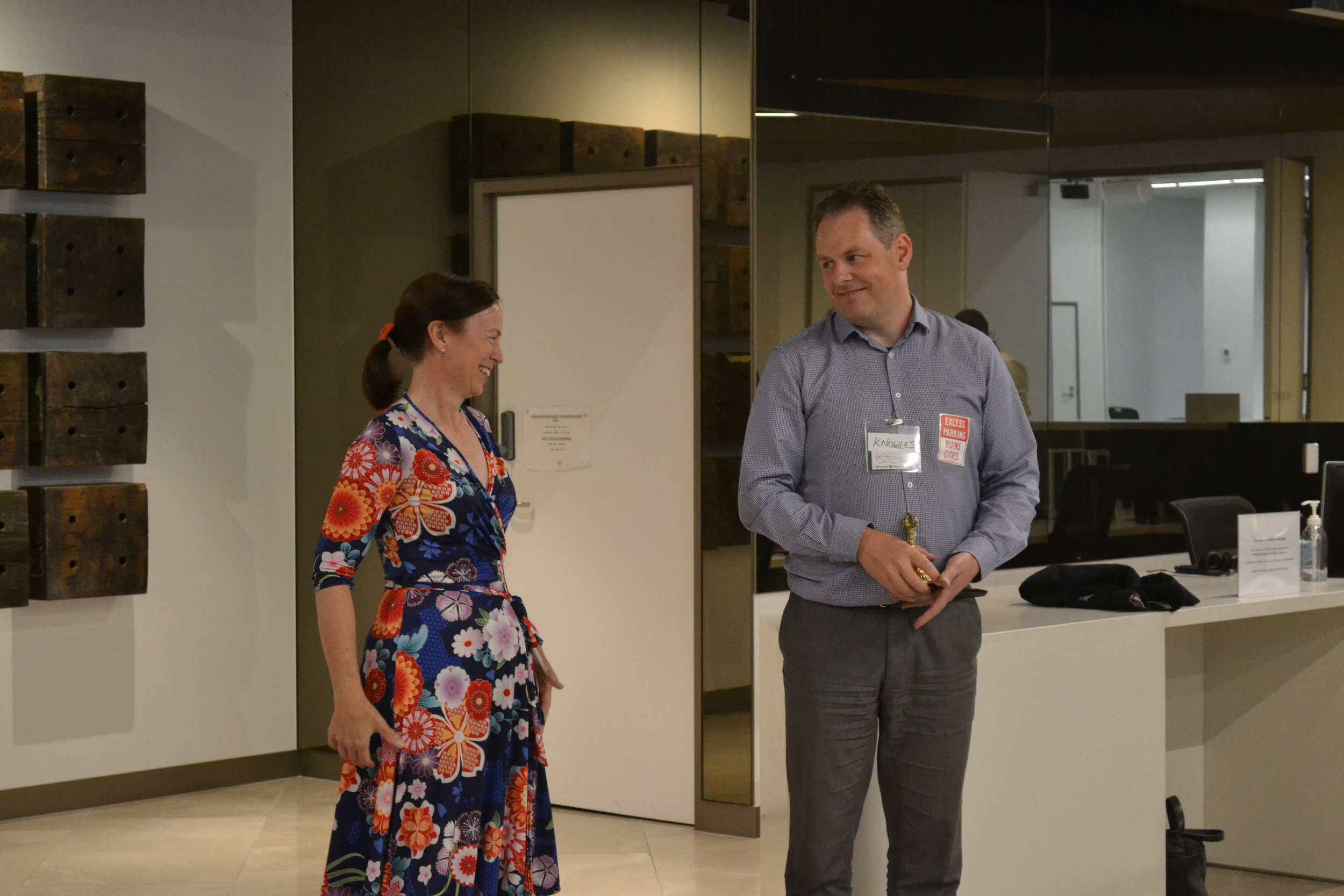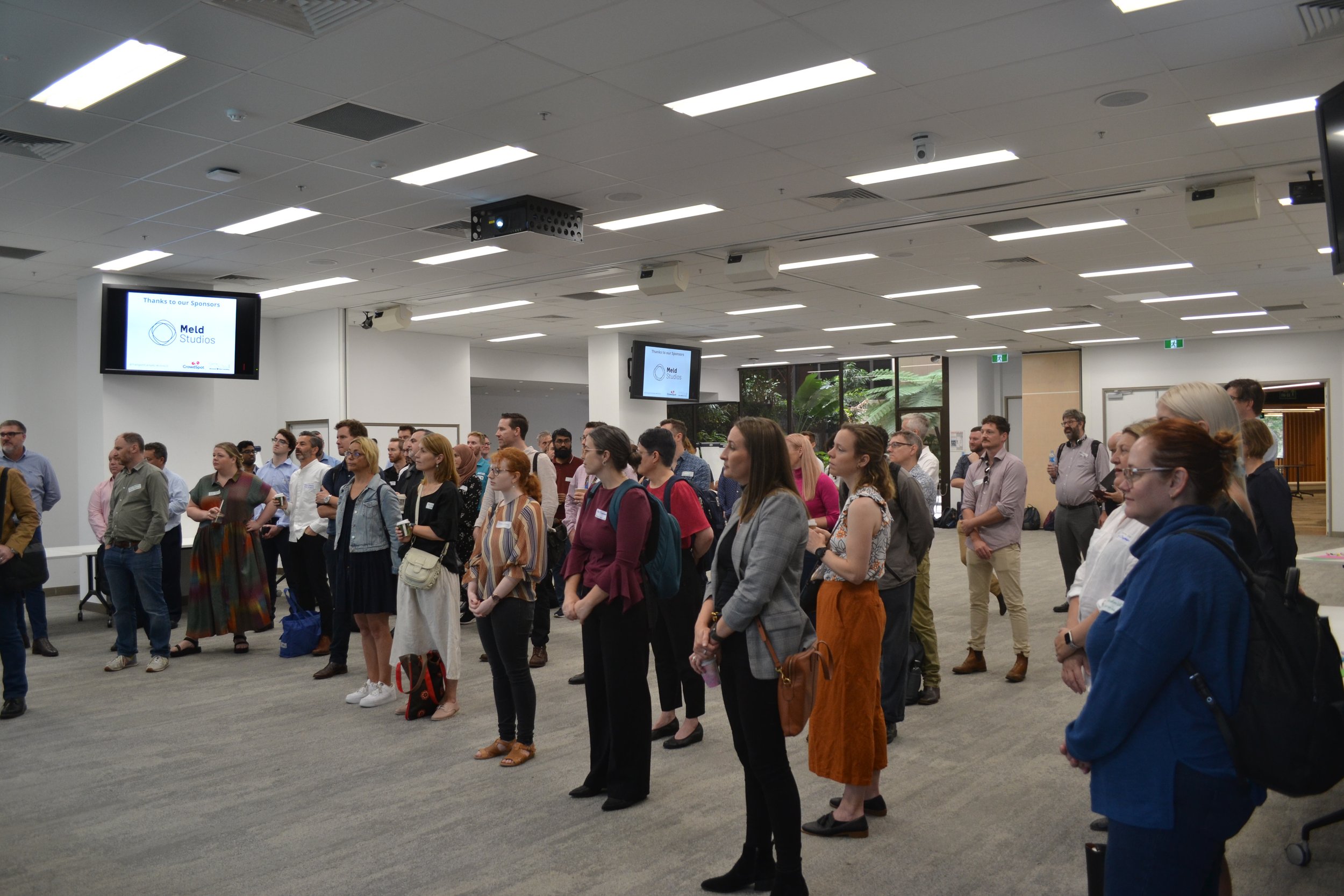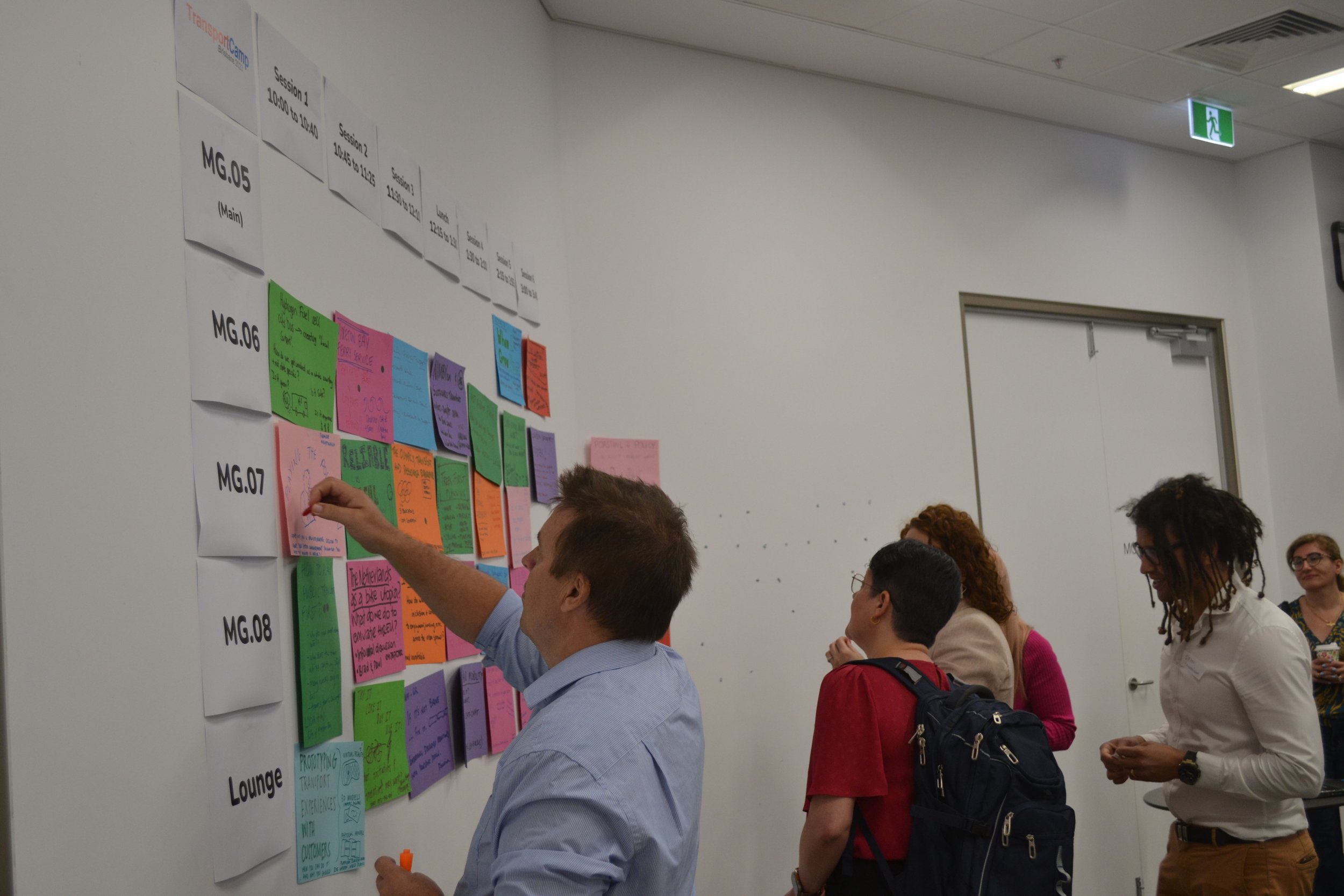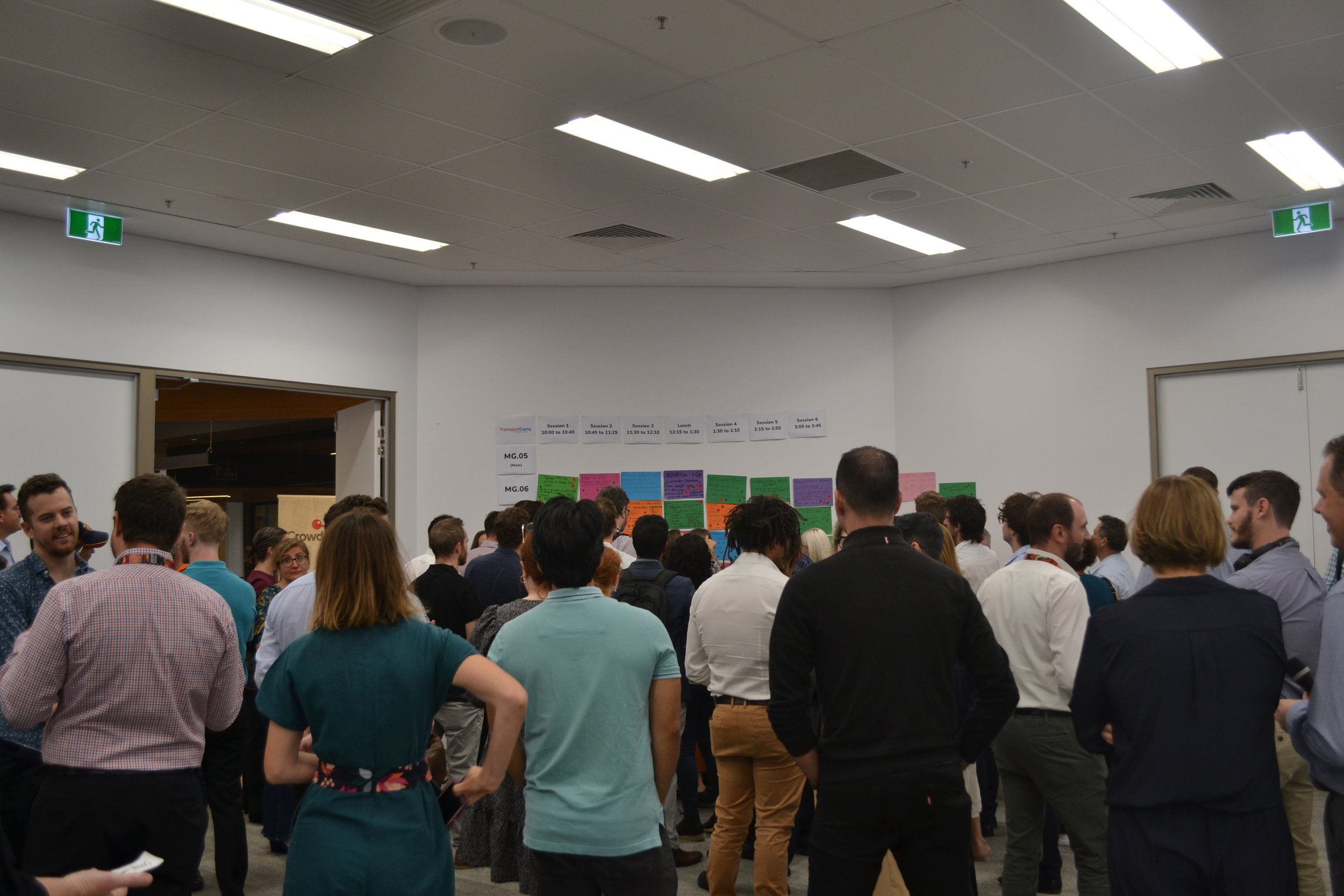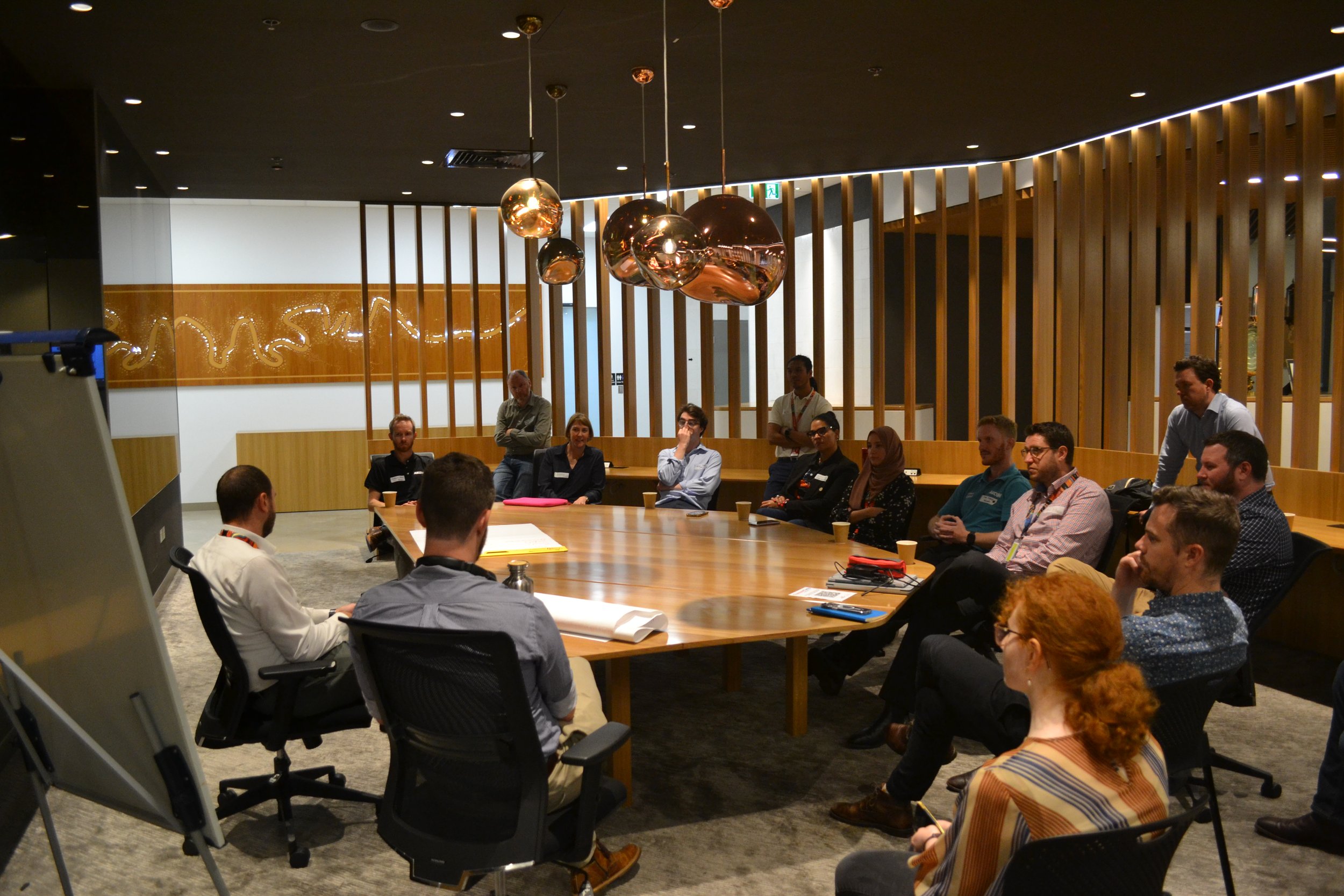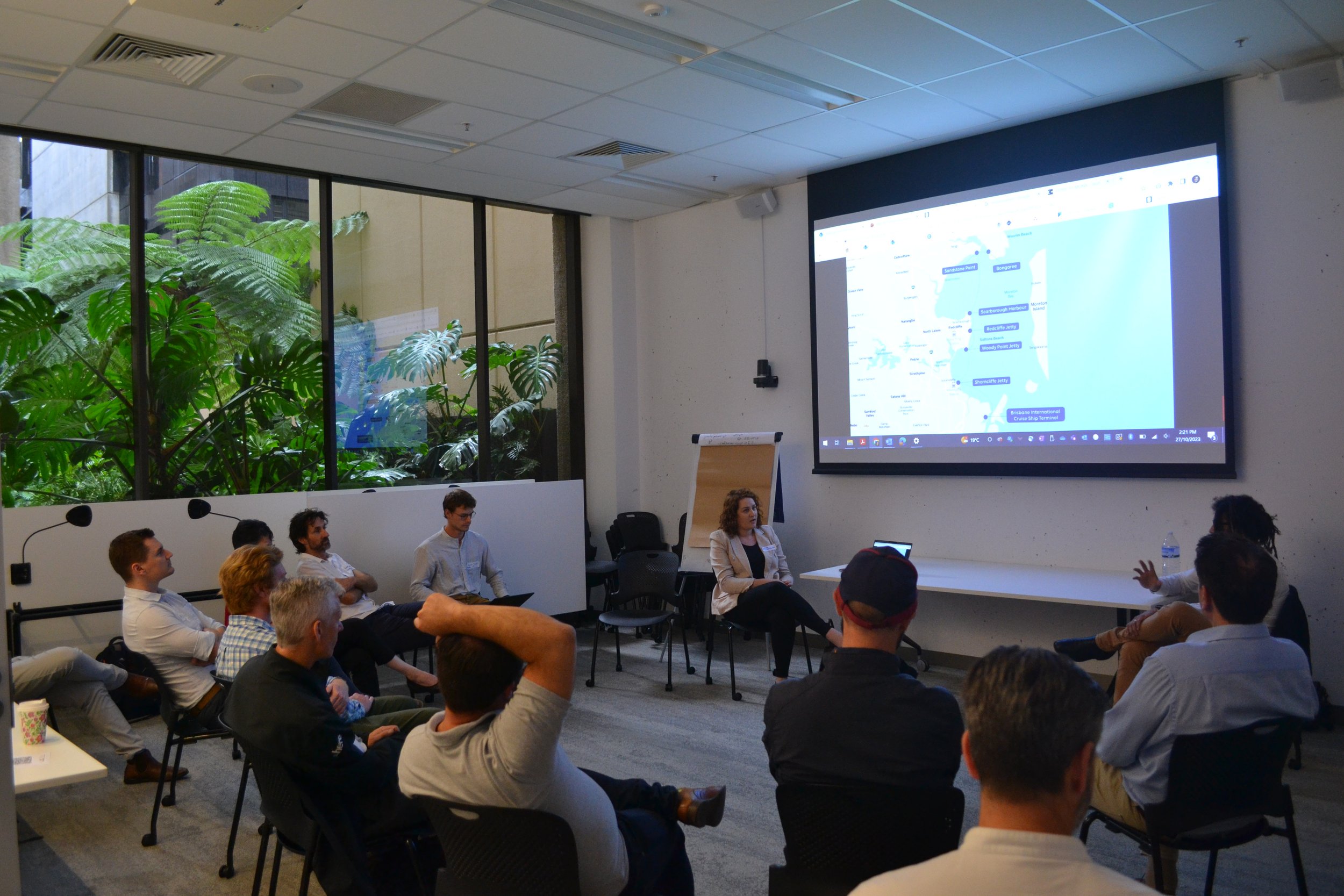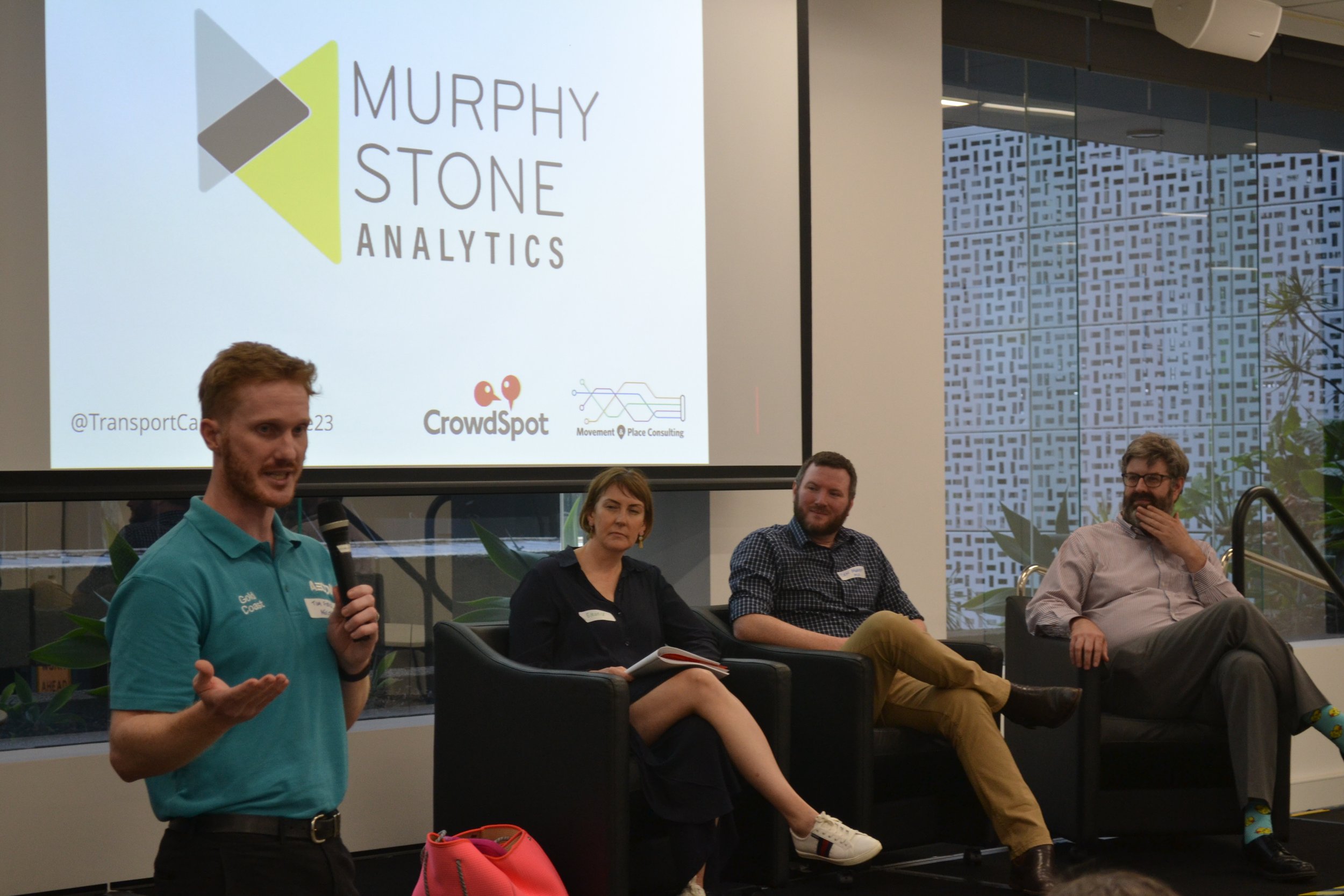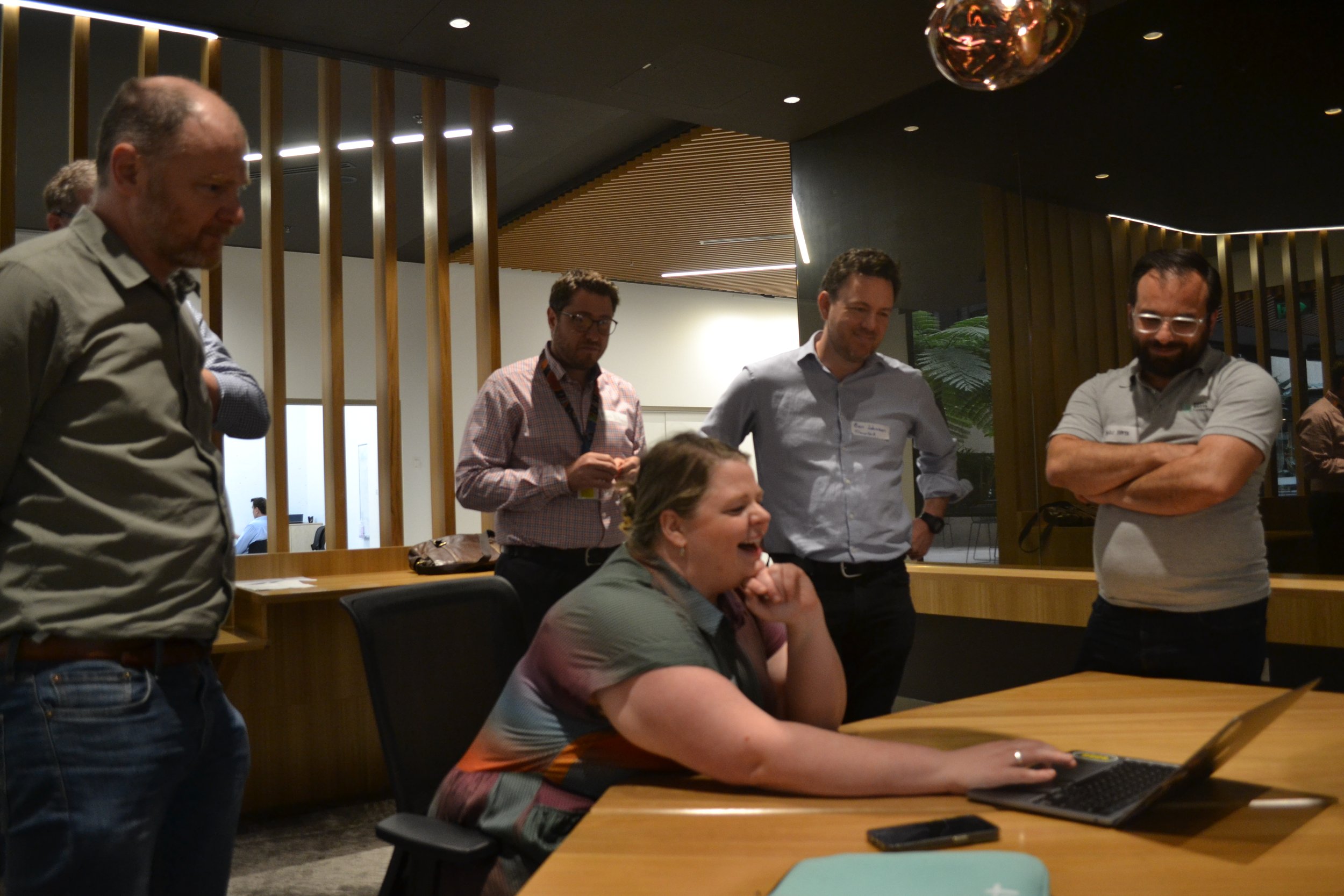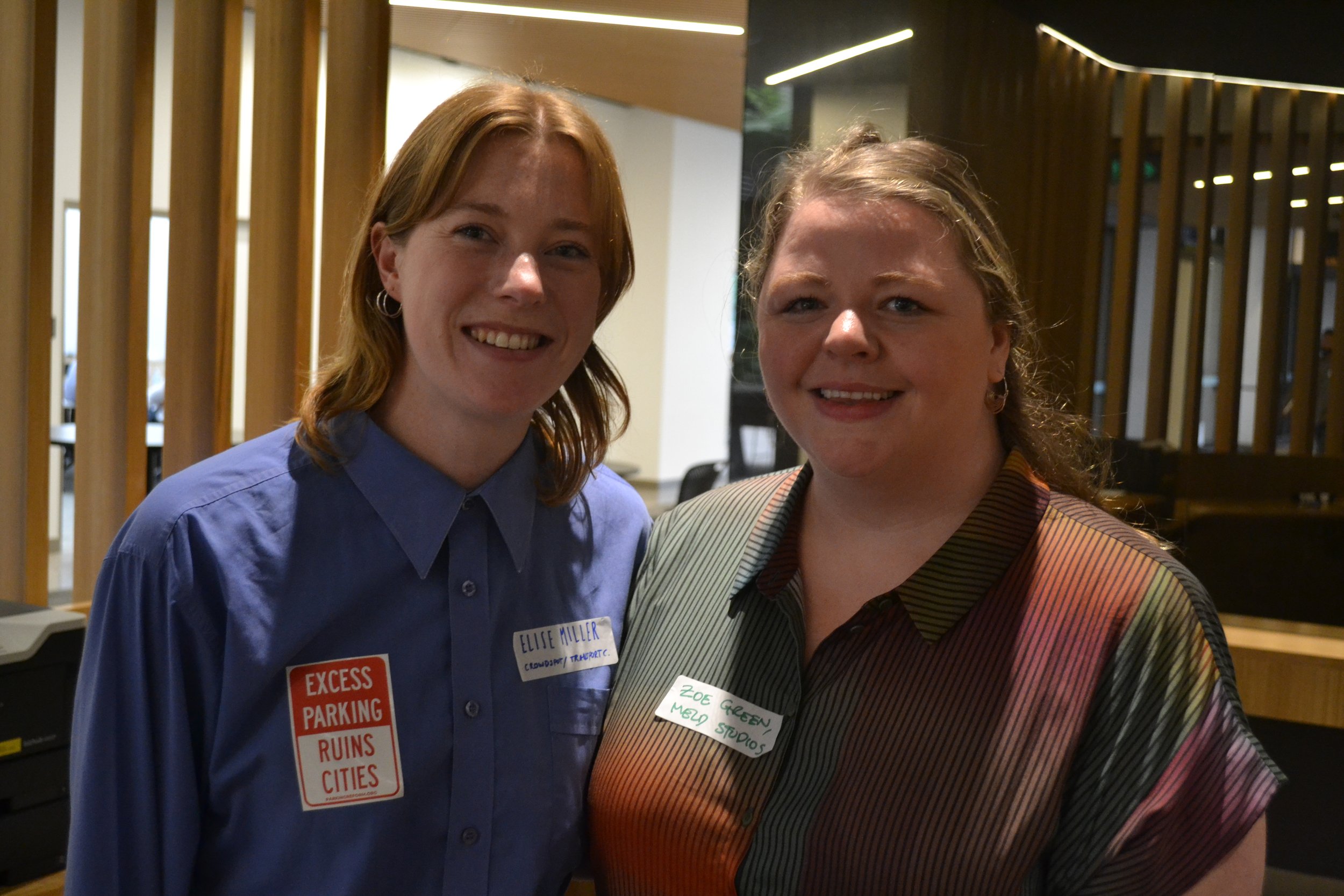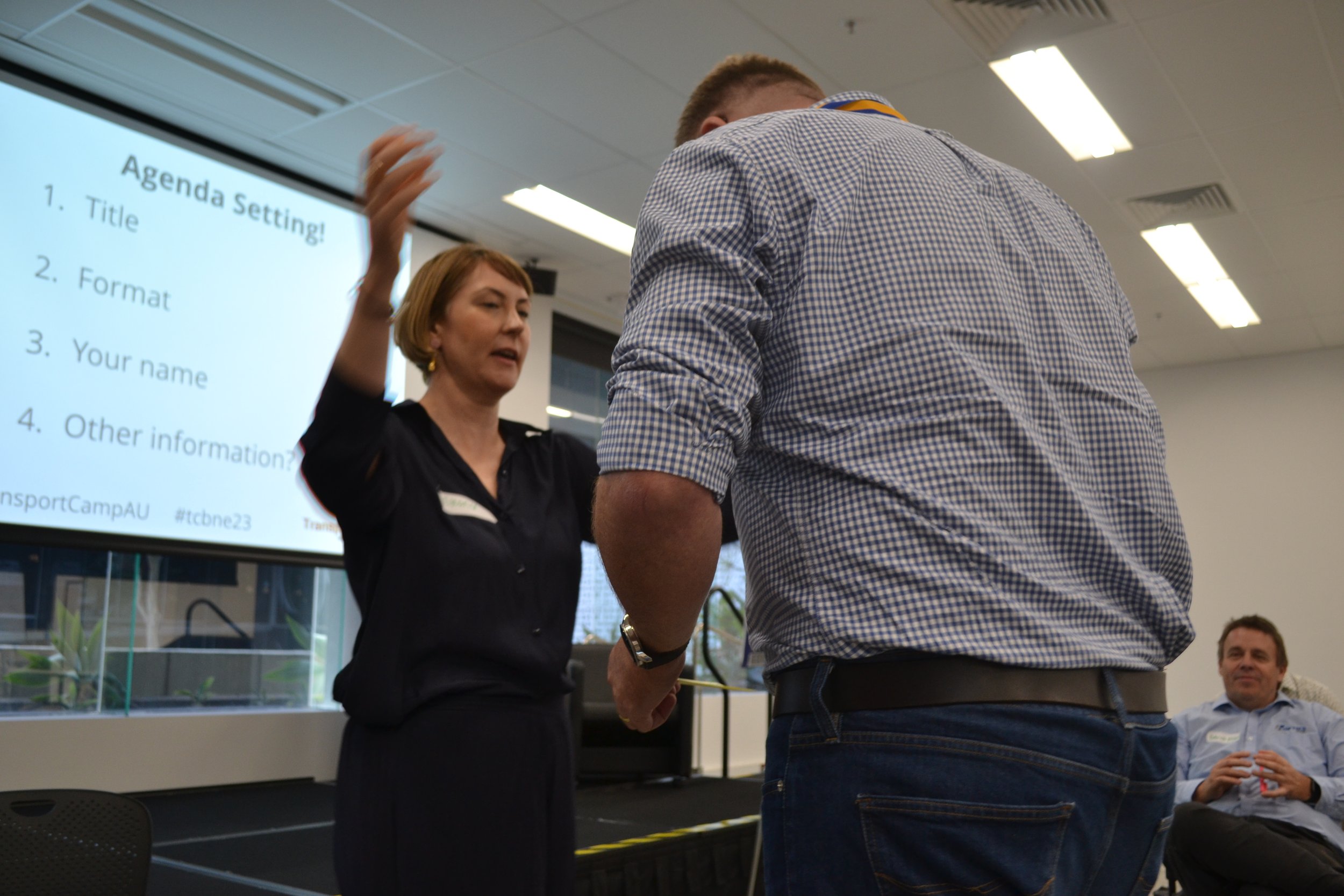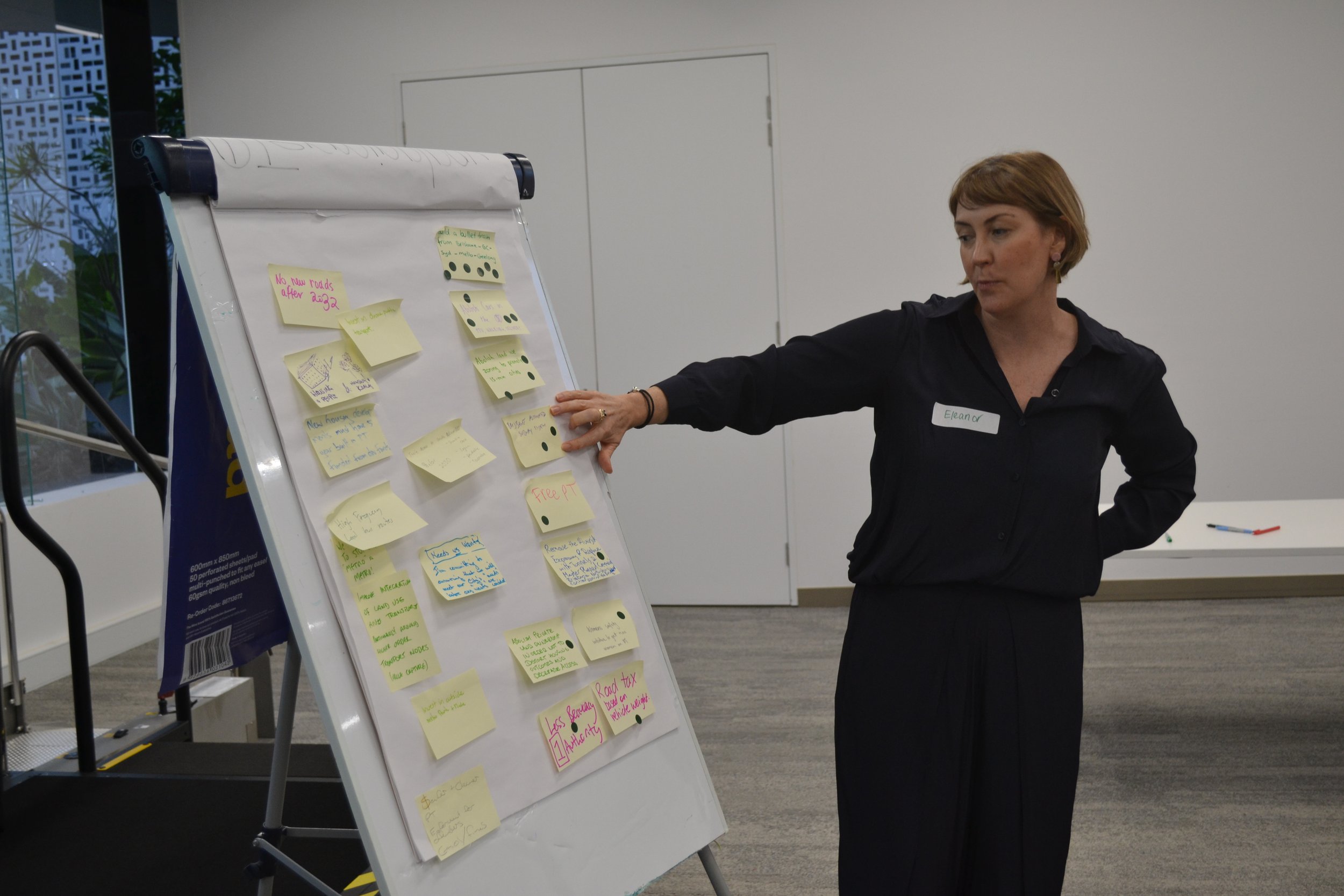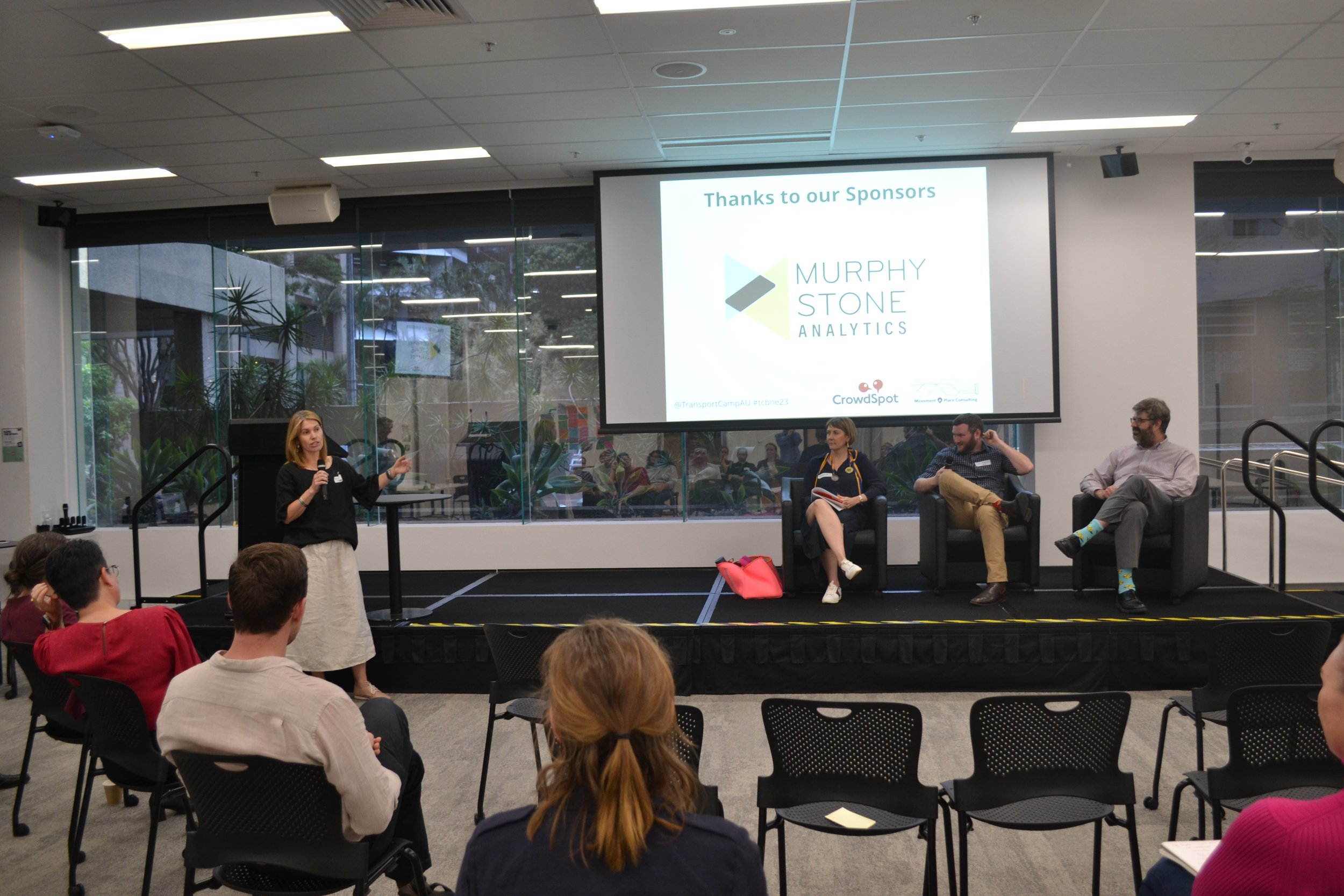2023 Brisbane Sessions
Session 1
Prototyping transport experiences with customers
Zoe Green and Iain Barker (Meld Studios)
Session: 1
Room: Lounge
Summary: Virtual Reality. Prototyping. Innovation.
What are the different ways we can interact with customers and envision our transport futures? Prototyping is about eliciting a response from someone. This is something we can test with customers. The intention of this process is to help improve a design or to make a decision. Zoe outlined how this is an iterative process. She posed; how does this change our response? Prototyping means you can be confident in what you are releasing in the world. Moving forward, how can we be productive rather than reactive? Iain discussed how this approach was employed to reimagine paper timetabling in Melbourne. How did the wider community react? Another example was prototyping wayfinding. Do people prefer switchback or parallel escalators? Prototyping helps us to identify what is intuitive.
“You can use an eraser on a drafting table or a sledgehammer on a construction site” -Frank Lloyd Wright
What does public transport need to look like to replace the convenience of your car
Lydia I & Zara Trengrove (Moreton Bay Council)
Session: 1
Room: Meeting Room 5
Summary: This session discussed the accessibility & feasibility of changing public transport to meet new demand. Some mitigation tactics used include: - integrating public transport options before developments are developed. - introducing demand based transit. Some key challenges include: - densification & introduction of public transport as an afterthought. - less demand as a cause of low frequency.
Road Pricing
Group Discussion
Session: 1
Room: Meeting Room 8
Summary: The house talked about road pricing in different cities around the world as examples. It was said that the current transport policy is not transparent and there should be more specific goals regarding alternative modes, toll price, inside city and outside, etc. along with public transport and micro-mobility.
Hydrogen City Bus vs Local Context
Iain Dorward (Foton Mobility)
Session: 1
Room: Meeting Room 6
Summary: Foton Mobility, a Hydrogen Buses company, is looking to enter the Queensland Market. The objective of this session was to introduce the opportunities and challenges of hydrogen buses (compared to battery electric buses), including energy consumption, storage, range, and infrastructure; and to find ways to facilitate entrance in the QLD context. One of the main points was that for both demand and supply, lowering the cost is crucial, and will primarily be achieved through economies of scale, massification of hydrogen supply, and take-up of hydrogen buses across the state.
NIMBYism and sustainable transport
Madison Bland (Cities Reserach Institute)
Session: 1
Room: Meeting Room 7
Summary: Meaningful engagement with the community is required to combat NIMBYism. “What’s in it for them” is required; listen to their fears using value-based messaging. How we frame a project is important—not just an X-type project, but community safety, health, and benefit. Lead them on the journey. Early engagement is necessary to gain support and communicate back learnings and how they have influenced the project. Target the consultation well: geographic segments; population segments. Paid attendance? Examples of good projects that started with negative community sentiments include High St, Auckland, Gold Coast Light Rail, and City of Yarra safe bicycle infrastructure. Takeaway: Learning the lesson of renewable energy earning social licence.
Session 2
Accounting for Transport Carbon Emissions
Laura Aston (Movement & Place Consulting)
Session: 2
Room: Meeting Room 6
Summary: This session addressed the gap currently existing between carbon accounting and transport models, and the current absence of a comprehensive framework. How can we truly evaluate carbon emission outcomes from transport projects? How to take into account, for example, shifts in behaviors, modal choices, land uses, that are associated with a specific project or policy? The discussion was rich, and although solutions were difficult to find to reconcile the complexity of transport modelling and the requirements of carbon accounting, this session was incredible food for thought.
Reliability vs usefulness - Unintended planning decisions that directly affect customer journey.
Ben Murphy (Murphy and Stone Analytics)
Session: 2
Room: Meeting Room 7
Summary: Customer priority #1: reliability. Impossible problem: services need to be fast, direct, and efficient; we also need to have services that are reliable. Because of conflicting constraints, often the first tool we call on is timetable padding. But the compounding effect of this over time can be catastrophic. It can also result in trying to chase the worst day rather than the usual day. There’s a lot of variability in the network that planners must manage. New tools can generate strange or unintended customer behaviour or give wrong or incomplete options to customers.
Takeaways:
Travel time data must be cleaned up to improve planning outcomes.
The optimum customer service result should be running one minute late.
Not everything in the network should be treated the same - one size fits all isn’t fit for purpose. A high-frequency service can have less reliability; a once-an-hour service cannot.
Trees First Planning! Trees as essential transport infrastructure
David Uhlmann (Aurecon)
Session: 2
Room: Lounge
Summary: Trees should be planned for up front to make pedestrians physically comfortable walking and encouraging mode shift away from cars. Trees provide shade, physical barriers between cars and people, and heat island reduction. But they need to be planned up front and not an afterthought.
Bikes, Infrastructure, Land Use Prioritisation
Brad (Aurecon)
Session: 2
Room: Meeting Room 8
Summary: The meeting discussed the challenges regarding bicycling in this city. These are cultural elements, legislation, infrastructure, and land use policy. It was concluded by discussing the possible solutions.
Playing the politician
Elenor Nightingale (Accession Consulting)
Session: 2
Room: Meeting Room 5
Summary: This presentation considered attendees acting like politicians & presenting election statements with a focus on transport. After presenting, all attendees “voted” A wide variety of action statements were presented including; introducing new modes of transport (bullet trains, underground metros), increasing accessibility of public transport & introducing of higher road usage fees to incentivise increased use in public transport.
Session 3
Keeping Connected; across the urban sprawl
Jemina Paul (TMR)
Session: 3
Room: Meeting Room 8
Summary: The discussion was about accessing urban facilities such as health and wellbeing, jobs, education, etc. Public transport, land tax, and micro-mobility were discussed. They concluded by conducting research on users' attitudes and opinions about the equitable urban domain, emphasised public transport and micro-mobility.
Spooky Disasters
Adrian Webb (Cities Research Institute Griffith University)
Session: 3
Room: Meeting Room 6
Summary: What can we do if three successive crises make public transit demand almost double in Southeast Queensland? This session, organised as a brainstorm, addressed this question. Several options, like taking seats out of some trains, encouraging work from home, giving out free bikes, encouraging carpooling, emerged.
However, those decisions always needed to find a place between short-term crisis management and long-term planning. It was actually revealed at the end of the session that similar patronage increases had happened in Victoria between 2006-2009, a crisis ‘solved’ at the time with extra trams shipped from France to respond to the emergency.
Operating contracts
Paul Davies (Cities Research Institute Griffith University)
Session: 3
Room: Meeting Room 7
Summary: Strike key clause to improve contracts—on-time running. Ten-year horizons on timetables hurt customers and operators. Contracts could operationalize good citizen behaviours to deliver better services. Current contracts rely too heavily on one tool to measure and solve everything. The contract manager's role is a huge pivot point, should identify KPIs that are meaningful, tease out the pain points, adapt the contract to suit desired outcomes, and establish problem-resolution processes that don’t immediately reach legal disputes. Look at the desired customer outcome and use data that measures that. Contracts need to be less prescriptive, and seek more collaboration between the operator and state.
Modeling and planning to understand transport needs.
Tom Grohovaz (TMR)
Session: 3
Room: Meeting Room 6
Summary: For this session, Tom took us outside to enjoy the sunshine and discuss software and transport modeling. Are we limited by the software that we currently use? One issue that was raised was the willingness of individuals to learn new software. If a certain software is familiar, are we locked into a certain type of solution? Rick Williams from Movement & Place expressed the importance of being aware of the various packages that exist. It is understandable that we cannot understand each software, but how can we diversify our work environments to ensure we cover these gaps? Machine learning is challenging in Transport Planning, as many decisions and ideas are informed by top-level decision-making. How can we ensure political influences do not impede transport innovation and the ongoing exploration of new thinking and approaches?
Session 4
Not Another Plan!
David Freer (Griffith University)
Session: 4
Room: Meeting Room 6
Summary: This session started from a relatively unanimous observation: ‘plans’ are not enough to get things done in transport. With current demographic growth rates and current investments in transport planning, Southeast Queensland is going towards ‘grid lock’. The discussion thus focused on ways to get things moving, in a situation where State government is not acting fast enough. A ‘lobbying’ group mixing local governments, academics, consultants, and businesses was evoked. Overall though, this is a complex topic, where escaping jading is not easy for professionals.
Perfect Transport Network
Arne Ancheta (Queensland Rail)
Session: 4
Room: Meeting Room 5
Summary: People in this session talked about circular roads/loops for public buses, and the frequency of services. Living in a joint family instead of a single couple might help manage land use. Also, micro-mobility took place as a solution to perfect road network. They said that the existing infrastructure and land use policy is not in the best service.
Fixing the Modal Hierarchy - You won’t believe this one small trick!
Zoe Green and Chris O'Brien (Meld Studios)
Session: 4
Room: Meeting Room 7
Summary: The modal hierarchy isn’t working and doesn’t address equitable user access and experience around stations. While active transport is part of the picture, it doesn’t address those with reduced choice due to mobility impairments, resulting in poor equity outcomes. The existing sustainable modal hierarchy is not fit for purpose. DDA compliance is a minimum requirement and not fit for purpose. Let’s advocate for both a sustainable and equitable modal hierarchy. Enabling and prioritising accessible drop-off points to be included in station design will deliver great outcomes for all. Use economic arguments to achieve the human-centered goal. Ensure everyone is using the same vocabulary and correctly framing the arguments. More than permanently disabled people will need accessible transport—broken limbs, prams, people with luggage, and sensory challenges. Harness people’s lived experiences and build evocative narratives to compel decision-makers to drive change.
Session 5
Opinion Polling: E-scooter Use, laws, and infrastructure
Xanthia Dubler (Zwarf Transport Planning)
Session: 1
Room: Meeting Room 7
Summary: Robust and entertaining interactive workshop. Only a small number of participants owned an e-bike or e-scooter. Through a series of increasingly provocative questions, the majority of the room was generally supportive of enabling e-scooter use. Concerns were raised about the minimum age of users for safety. Opinion was split on increasing regulation and enforcement. Additional conversation explored the business model and operating processes. Discussion of use/r patterns arose when considering geofencing or time-limiting e-scooters. Despite the perception that drunks were late-night users, data reveals late-night shift workers and women seeking a faster trip for safety reasons. Takeaway: E-mobility has a place, has improved awareness of other active transport users and experience, and requires improved regulation/management.
Moreton Bay Ferry Service
Chelsea Van Riet (City of Moreton Bay)
Session: 5
Room: Meeting Room 6
Summary: This session was led by the city of Moreton Bay, presenting their scoping exercise for a potential 'BayCat' service across Moreton Bay, linking seven ferry stops along the coast, from Bribie Island all the way down to the Brisbane International Cruise Terminal. While the project is still at a very early phase, and mostly based on a demand study, the discussion was very lively, focusing on opportunities such as development around ferry stops, but also on potential challenges, such as competition with other modes of transport (i.e. high-speed rail transit) and environmental impacts on the Bay.
Session 6
Thomas (SMEC)
Session: 6
Room: Meeting Room 5
Format: Shark Tank
Summary: Should 1 Billion dollars be provided to subsidise transport infrastructure? Thomas explores the housing crisis: how can we counteract land banking, urban sprawl, and the housing crisis? The goal is to subsidise infrastructure to incentivise development increase within proximity to public transport. Can we support the relationship between high-density development and infrastructure? Thomas was asked, instead of a one billion subsidy, why don’t we direct this money directly into building social housing. This question raised an ideal situation, however, political pressures allow this proposal to be more palatable through a subsidiary approach. Who will build the social housing? On what land? This initiative explores how to deliver change on private land.
Rick Williams (Movement & Place Consulting)
Session: 6
Room: Meeting Room 7
Format: Open Data
Summary: Any data can be open if you work hard enough. While there is amazing data available, it may not be used very well. Many data sources could be improved/refined. Government agencies are now commissioning consultancies to do this. Dashboard summaries/outputs are useful as long as the raw data is readily identified. Third-party data sources limit what can be done with final products and distribution. Wide-ranging discussion covering current, past, and in-development data sets, who owns what, and what you can do with it.
Iain Barker (Meld Studios)
Session: 6
Room: Meeting Room 5
Format: Shark Tank
Summary: Would you commit 2.2 Billion dollars (au) to make Brisbane to be known as the greenest city in the world? In this proposal, Iain asks the Sharks what would it take to receive the funding to transform the entire transport system in favour of sustainable and active transport modes.
